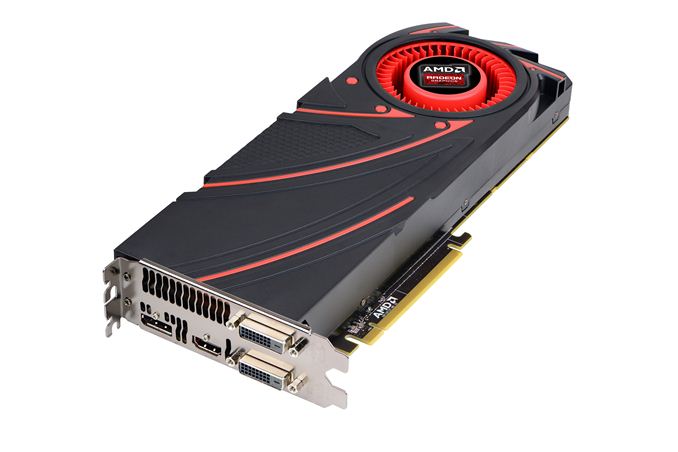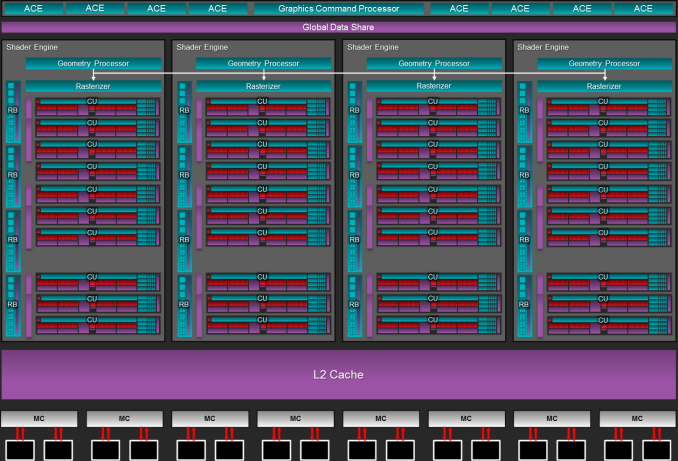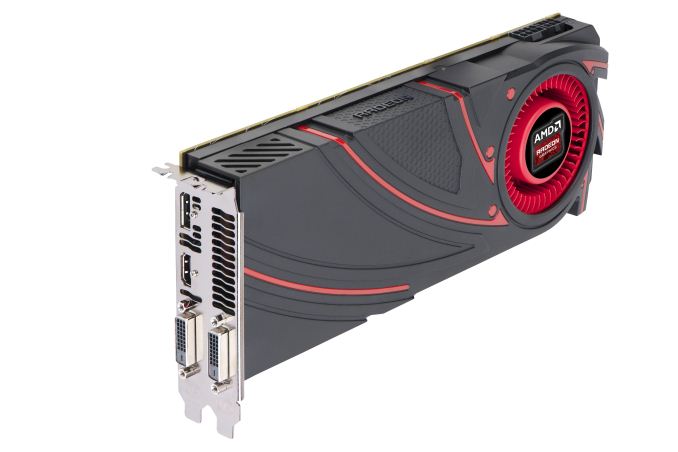The AMD Radeon R9 290 Review
by Ryan Smith on November 5, 2013 12:01 AM EST- Posted in
- GPUs
- AMD
- Radeon
- Hawaii
- Radeon 200

With the launch of AMD’s Radeon R9 290X less than 2 weeks ago, the video card marketplace has become very active very quickly. The 290X not only reasserted AMD’s right to fight for the video card performance crown, but in doing so it has triggered an avalanche of pricing and positioning changes that have affected both NVIDIA and AMD.
NVIDIA for their part cut the price of the GTX 780 and GTX 770 to $500 and $330 respectively, repositioning the cards and giving them their first official price cuts since their spring launches. Meanwhile AMD has also made some changes, and although 290X is unaffected for the moment, 290 was affected before it even launched, receiving an arguably significant specification adjustment. Consequently with GTX 780’s price cut being NVIDIA’s counter to 290X, 290 has gone from just being a lower tier Hawaii card to also being AMD’s counter-counter, and in the process has become a somewhat different card than what it was going to be just one week ago.
But before we get ahead of ourselves, let’s start at the beginning. With the successful launch of the 290X behind them, and the equally successful launch of their new flagship GPU Hawaii, AMD is ready to make their next move. Launching today will be the Radeon R9 290, the obligatory lower-tier part for AMD’s new flagship lineup. Making the usual tradeoffs for a lower-tier part, AMD is cutting down on both the number of functional units and the clockspeeds, the typical methods for die harvesting, in exchange for a lower price. Now officially AMD has not announced the Radeon R9 290 in advance, but with listings for it having already gone up on the same day as the 290X, it’s something that everyone has been expecting.
As always we’ll offer a full breakdown of performance and other attributes in the following pages, but before we even begin with that we want to point out that the 290 is going to be one of AMD’s most controversial and/or hotly debated launches in at least a couple of years. The merits of 290X were already hotly debated in some gaming circles for its noise relative to its performance and competition, and unfortunately 290 is going to be significantly worse in that respect. We’ll have a full rundown in the following pages, but in a nutshell AMD has thrown caution into the wind in the name of maximizing performance.
| AMD GPU Specification Comparison | ||||||
| AMD Radeon R9 290X | AMD Radeon R9 290 | AMD Radeon R9 280X | AMD Radeon HD 7970 | |||
| Stream Processors | 2816 | 2560 | 2048 | 2048 | ||
| Texture Units | 176 | 160 | 128 | 128 | ||
| ROPs | 64 | 64 | 32 | 32 | ||
| Core Clock | 727MHz | 662MHz | 850MHz | 925MHz | ||
| Boost Clock | 1000MHz | 947MHz | 1000MHz | N/A | ||
| Memory Clock | 5GHz GDDR5 | 5GHz GDDR5 | 6GHz GDDR5 | 5.5GHz GDDR5 | ||
| Memory Bus Width | 512-bit | 512-bit | 384-bit | 384-bit | ||
| VRAM | 4GB | 4GB | 3GB | 3GB | ||
| FP64 | 1/8 | 1/8 | 1/4 | 1/4 | ||
| TrueAudio | Y | Y | N | N | ||
| Transistor Count | 6.2B | 6.2B | 4.31B | 4.31B | ||
| Typical Board Power | ~300W (Unofficial) | ~300W (Unofficial) | 250W | 250W | ||
| Manufacturing Process | TSMC 28nm | TSMC 28nm | TSMC 28nm | TSMC 28nm | ||
| Architecture | GCN 1.1 | GCN 1.1 | GCN 1.0 | GCN 1.0 | ||
| GPU | Hawaii | Hawaii | Tahiti | Tahiti | ||
| Launch Date | 10/24/13 | 11/05/13 | 10/11/13 | 12/28/11 | ||
| Launch Price | $549 | $399 | $299 | $549 | ||
Diving right into the hardware specifications, Radeon R9 290 is a bit more powerful than usual for a lower-tier part. AMD has cut the number of CUs from 44 to 40 – disabling 1 CU per SE – while adjusting down the base GPU clockspeed and boost GPU clockspeed to from 727MHz and 1000MHz to 662MHz and 947MHz respectively. However AMD has not cut the amount of memory, the memory clockspeed, the memory bus width, or the number of ROPs, leaving those at 5GHz for the memory clockspeed, 512-bits for the memory bus width, and all 64 ROPs for the back-end hardware.
As a result the differences between the 290 and 290X are on paper limited entirely to the clockspeed differences and the reduced number of CUs. At their top boost bins this gives 290 95% the clockspeed of 290X, and 91% of the shader hardware, giving 290 100% of 290X’s memory performance, 95% of 290X’s ROP and geometry performance, and 86% of 290X’s shading/texturing performance.
Compared to AMD’s last generation offerings, the 290 is going to be closer to 290X than 7950 was to 7970. 290 retains a larger percentage of 290X’s shader and ROP performance, never mind the fact that the full 320GB/sec of memory bandwidth is being retained. As such despite the wider price difference this time around, performance on paper is going to be notably closer. Paper will of course be the key word here, as in the case of 290 more so than any other card we’ve looked at in recent history theory and practice will not line up. Compared to the 290X, practice will be favoring the 290 by far.
Moving on to power consumption, perhaps because of AMD’s more aggressive specifications for their lower-tier card this time around, power consumption is not dropping at all. AMD is still not throwing us any useful hard numbers, but based on our performance data we estimate the 290 to have a nearly identical TDP to the 290X, leading us to keep it at an unofficial 300W. Lower-tier parts typically trade performance for power consumption, but that will not be the case here. Power consumption will be identical while performance will be down, so efficiency will be slipping and 290 will have all the same power/cooling requirements as 290X.
Meanwhile like the 290X launch, the 290 launch is going to be a hard launch, and a full reference launch at that. As such we’ll be seeing 290 cards go up for sale at the usual retailers today, with all of those cards using AMD’s reference cooler and reference board, itself unchanged from the 290X.
As for pricing and competitive positioning, AMD will be launching the 290 at what we consider to be a very aggressive price of $399. Based on the initial specifications, the performance, and the competition, we had been expecting AMD to launch this at $449, mirroring the launch of the 7950 in the process. But AMD has gone one step further by significantly undercutting both themselves and NVIDIA.
290’s immediate competition on the AMD side will be the $549 290X above it and the $299 280X below it, while on the NVIDIA side the competition will be the $499 GTX 780 above it and the $329 GTX 770 below it. Pricing wise this puts 290 as closer competition to 280X/GTX 770 than it does the high-tier cards, but as we’ll see in our benchmarks AMD is aiming for the top with regards to performance, which will make price/performance comparisons both interesting and frustrating at the same time.
NVIDIA for their part will have their 3 game Holiday GeForce Bundle on the GTX 780 and GTX 770, presenting the same wildcard factor for overall value that we saw with the 290X launch. As always, the value of bundles are ultimately up to the buyer, especially in this case since we’re looking at a rather significant $100 price gap between the 290 and the GTX 780.
| Fall 2013 GPU Pricing Comparison | |||||
| AMD | Price | NVIDIA | |||
| Radeon R9 290X | $550 | ||||
| $500 | GeForce GTX 780 | ||||
| Radeon R9 290 | $400 | ||||
| $330 | GeForce GTX 770 | ||||
| Radeon R9 280X | $300 | ||||
| $250 | GeForce GTX 760 | ||||
| Radeon R9 270X | $200 | ||||
| $180 | GeForce GTX 660 | ||||
| $150 | GeForce GTX 650 Ti Boost | ||||
| Radeon R7 260X | $140 | ||||












295 Comments
View All Comments
YazX_ - Tuesday, November 5, 2013 - link
This is the case for reference designs, i wouldnt expect that custom designs will suffer from noise and heat issues, as an example, 770 GTX reference temp under load is 80c, i have 770 gtx Gigabyte OC windforce3 andi have never seen the GPU temp reaching 65.290 for now is the best bang for the buck, gr8 job AMD, and for us, it means another price cut from Nvidia which is the best part in these competitions.
yeeeeman - Tuesday, November 5, 2013 - link
I think there is too much critic made on the subject of noise. You get a water block and the problem is solved. And you also pay less money for this combo, than what you would've pay'd for a GTX780.But, the thing that really strikes back from this review, is the unused potential of the 290X. Just imagine how it would run unlimited by its cooling system. I think it could hold its own against the comming 780Ti from nVidia.
And, we should stimulate AMD, because if it weren't for them, nVidia wouldn't ever dropped their prices. Now, they are even releasing the full GK110 core, at a smaller price than Titan.
TheJian - Tuesday, November 5, 2013 - link
So how many people you think there are running water? Also how much does that add to the cost of my shiny new hot card? Newegg isn't likely to be shipping water cooled cards by the millions...LOL. You are aware this is a REF NV card tested too right?Tomshardware seems to think noise and heat and how it runs IN GAMES after a period of time is an issue:
http://www.tomshardware.com/reviews/radeon-r9-290-...
"On the R9 290X we received from AMD, and in the seven games we tested, a 40% fan speed is good enough to average about 874 MHz. But when you’re actually gaming on a hot card (and not just benchmarking a cold one), our two-minute Metro: Last Light test suggests you’ll be spending more of your time in the upper-700 MHz range. In fact, in some titles, you’ll dip under 1000 MHz before even getting out of the menu system and into the action (Arma and BioShock).
You could call that questionable marketing. After all, the only way you’ll actually see a sustained 1000 MHz is if you either let the R9 290X’s fan howl like a tomcat looking for action or play platform-bound games."
How fast will these be after running a few hours in game? Or even 1hr? Most won't purchase water for any gpu so they'll be dealing with it as it is or with a better fan at some point (assuming OEM's get them soon):
"AMD’s scheme undoubtedly suffers a lack of clarity, and after piling praise onto the R9 290X’s value story, I now have to hope that Nvidia doesn’t follow AMD down this muddy little rabbit hole."
I hope they don't follow AMD and release a driver tomorrow doing the same crap too. But if I was them that is EXACTLY what I'd do in response along with videos everywhere explaining this should not be done, "but we have to do the same crap the other guys pull to beat us and when pulling this crap, you can clearly see there is no reason for us to drop prices agian" :) Or something like that...LOL. I really think AMD is going to be hurt by people buying the first rev and complaining all over forums about their silent PC (or nearly noise free) sounding like a jet engine now. Also as toms points out, are people really going to get the full perf while playing for longer than COLD periods that reviews bench under? A lot of people game for HOURS and they noted it slowing down even in menus before even playing the actual game. How does this card affect the rest of the temps in your PC during hours of playing? How does a gpu temp of 94 affect the PC vs. 81 for NV? I'll take 81 thanks.
1H4X4S3X - Tuesday, November 5, 2013 - link
Does anyone remember Ryan Smith's review of the even louder GTX 480?Anyone who can't see the bias is blind himself.
Drunktroop - Tuesday, November 5, 2013 - link
You treat FurMark as a more meaningful/real-life test than Crysis 3?silverblue - Tuesday, November 5, 2013 - link
Shh.The simple fact is, whilst incredibly fast, this baby needs modding with a better cooling solution. Early adopters are usually hit the hardest, so I'd recommend waiting until customised cards hit the shelves. A GTX 780-style cooler would be very interesting indeed.
Ryan Smith - Tuesday, November 5, 2013 - link
Which is actually why we threw in the GTX 480 in our charts for this one, to offer some perspective. The GTX 480 is quieter than the 290.chizow - Tuesday, November 5, 2013 - link
And certainly you must account for the possibility that expectations and tolerances change over time right? Read the 580 review and you will see he says it is basically "Fermi Done Right", setting the new standard for high-end temps and cooling. The 580 design put a ring on the fan to reduce the whine on the fan, so to go back to something as shrill and annoying is easily understood as taking a step in the wrong direction.chizow - Tuesday, November 5, 2013 - link
To add to that, there was a time 60mm and 80mm high RPM fans were the norm on CPU coolers, no longer, I could never stand for one of those high-pitched coolers again now what we are spoiled with 120mm/140mm CPU fans or multiple fans on radiators.Drunktroop - Tuesday, November 5, 2013 - link
I think you should be ready for noise when the maker is not willing to disclose power figures?Too bad Hawaii for SFF gaming is a no-go.
From performance perspective it is unbeatable.